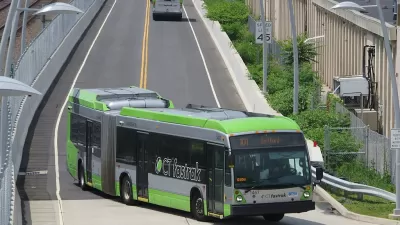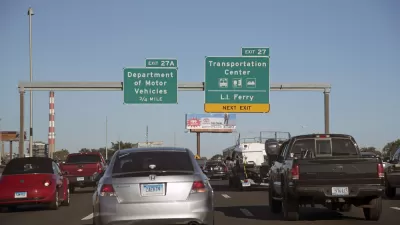A case study of media coverage in Connecticut finds a double standard between the CTFastrak and Interstate 84 projects.
Joseph Cutrufo examines the discrepancies in the scrutiny afforded two transit projects in Connecticut: CTfastrak and the widening of Interstate 84 in Waterbury. Cutrufo begins by noting the similarities between the two projects: "They’re both major transportation projects aimed at improving mobility, both became visible to the traveling public in the spring of 2015, and both cost hundreds of millions of dollars."
Yet despite those similarities, "it seems that the Connecticut Department of Transportation is being asked to justify the amount it’s spending on the bus rapid transit service, while spending on major highway projects seems to be accepted without much media scrutiny."
Seemingly opposed to the CTFastrak, is the Hartford Courant, which has reported and editorialized about a large jump in costs for the system. Cutrofo, however, thinks the focus on increased costs misses much of the point:
"It’s a substantial increase, but that original subsidy estimate is eight years old (though ConnDOT Commissioner Redeker probably shouldn’t have been 'quoting the $10 million figure with no caveats or disclaimers' as recently as 2014 — good sleuthing by the Courant). Since then, ConnDOT had expanded its service plan, which makes the system more useful and convenient, which in turn drives up ridership. And it’s working. Average daily ridership, according to the same article, is over 16,000, about 50 percent higher than the expected 11,200 daily riders."
The article includes by noting the lack of analysis or critique for the 2.7-mile widening project on I-84. In effect, according to Cutrofo, the media and the public declare the following: "No more bottleneck? By any means necessary! More money to subsidize bus riders? Let’s see your numbers."
FULL STORY: Scrutiny for Transit Projects, but Not for Highways

Planetizen Federal Action Tracker
A weekly monitor of how Trump’s orders and actions are impacting planners and planning in America.

San Francisco's School District Spent $105M To Build Affordable Housing for Teachers — And That's Just the Beginning
SFUSD joins a growing list of school districts using their land holdings to address housing affordability challenges faced by their own employees.

The Tiny, Adorable $7,000 Car Turning Japan Onto EVs
The single seat Mibot charges from a regular plug as quickly as an iPad, and is about half the price of an average EV.

Seattle's Plan for Adopting Driverless Cars
Equity, safety, accessibility and affordability are front of mind as the city prepares for robotaxis and other autonomous vehicles.

As Trump Phases Out FEMA, Is It Time to Flee the Floodplains?
With less federal funding available for disaster relief efforts, the need to relocate at-risk communities is more urgent than ever.

With Protected Lanes, 460% More People Commute by Bike
For those needing more ammo, more data proving what we already knew is here.
Urban Design for Planners 1: Software Tools
This six-course series explores essential urban design concepts using open source software and equips planners with the tools they need to participate fully in the urban design process.
Planning for Universal Design
Learn the tools for implementing Universal Design in planning regulations.
Smith Gee Studio
City of Charlotte
City of Camden Redevelopment Agency
City of Astoria
Transportation Research & Education Center (TREC) at Portland State University
US High Speed Rail Association
City of Camden Redevelopment Agency
Municipality of Princeton (NJ)




























